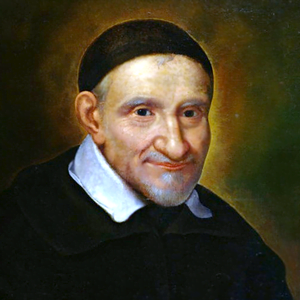
Vincent de Paul was a Gascon, born into a peasant family. Ordained a priest at the age of nineteen, he went to Paris in search of a benefice, after having endured two years in captivity among the Muslims. He became chaplain to Queen Margaret of Valois, obtained the revenues of an abbey and some parish appointments, and later served as tutor to the family of Philippe Emmanuel de Gondi, general of the galleys, where he began a remarkable ministry among the galley convicts.
His life was decisively shaped by contact with figures such as Cardinal Pierre de Bérulle and Saint Francis de Sales, who appointed him superior of the Sisters of the Visitation. His influence reached even the royal court: he assisted King Louis XIII on his deathbed, and under the regency of Anne of Austria he was named to the Council of Conscience, where he acted in effect as a minister of charity, until he withdrew due to opposition from Cardinal Mazarin.
The priestly work of Vincent is extraordinarily rich, yet four institutions in particular stand out: the Confraternity of the Ladies of Charity; its male counterpart, the Servants of the Poor; the Congregation of the Mission (the Lazarists or Vincentians), dedicated above all to missions and the formation of clergy; and, with the collaboration of Saint Louise de Marillac, the Daughters of Charity. From the renowned “Tuesday Conferences” at Saint-Lazare, attended by some two hundred and fifty priests, twenty-two were later named bishops on Vincent’s recommendation.
An excellent organizer—perhaps more than an innovator—cautious by temperament, Vincent was also affable, with a sense of humor, and edifying in his deep yet simple piety.
He died in Paris on September 27, 1660, and was canonized in 1737. Until the reform of the Roman calendar, his memorial was observed on July 19; it is now kept on the anniversary of his death.




